

| Archive Blog Cast Forum RSS Books! Poll Results About Search Fan Art Podcast More Stuff Random |
|
Classic comic reruns every day
|
1 {photo of Uranus}
1 Caption: God of the Sky
|
First (1) | Previous (3282) | Next (3284) || Latest Rerun (2895) |
Latest New (5380) First 5 | Previous 5 | Next 5 | Latest 5 Annotations theme: First | Previous | Next | Latest || First 5 | Previous 5 | Next 5 | Latest 5 This strip's permanent URL: http://www.irregularwebcomic.net/3283.html
Annotations off: turn on
Annotations on: turn off
|
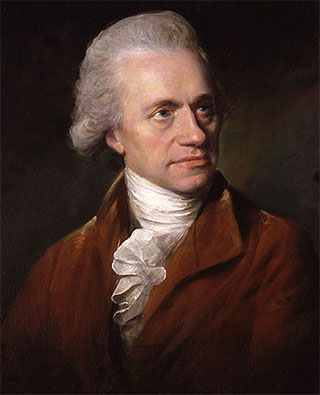 William Herschel, painted by Lemuel Abbott. Public domain image from Wikimedia Commons. |
Born Friedrich Wilhelm Herschel in Hanover, he was a talented musician from a young age. With war looming on the Continent, Wilhelm, 19, and an older brother were sent to England for safety by their father in 1757. Wilhelm became William and lived in England for the rest of his life. He spent the next 15 years playing and composing to great acclaim, and even became the musical director of a group in Bath. Over this time, Herschel's interest in music led him to the patterns of mathematics and then into astronomy. He had become a keen stargazer.
In 1772, Herschel's sister Caroline also arrived in England and took up residence in his household. She shared his interest in astronomy and together they built telescopes and made many observations. Caroline made significant contributions to astronomy in her own right, discovering several comets and nebulae, and making corrections to the star positions listed in the best star catalogue of the day, that of John Flamsteed, the first Astronomer Royal, back in Isaac Newton's day.
William's interest lay in stars that appeared to be very close to one another. Astronomers of the time considered it likely that the stars might be moving through space, but obviously any motion was too slow to be seen easily from Earth within a human lifetime. By finding stars that happened to line up so that they appeared very close together in the sky, the small angle between them could be measured more precisely than the position of an isolated star, and so any relative motion might be seen more easily.
Furthermore, if such motion between two closely aligned stars could be seen, and one of the stars wobbled back and forth exactly once per year, then the motion could be attributed to the parallax caused by Earth's orbit, and the distance to the nearer star measured. This would be a breakthrough measurement, so naturally many astronomers of the time were keen on making the discovery.
Herschel began by scouring the night sky for close pairs of stars. As he searched, he found that they were much more common then anyone had expected. The assumption was that stars were scattered randomly throughout space, and only on relatively rare occasions would two be lined up so precisely as to appear very close together from our vantage point on Earth. But Herschel found so many close stars, over 800 pairs or multiple groups, that he began to suspect something else was going on.
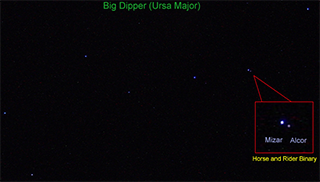 Multiple star system of Mizar and Alcor in the Big Dipper. Creative Commons Attribution-Share Alike image by Shawn E. Gano from Wikimedia Commons. |
We now know that most stars are in gravitationally bound binary or multiple systems with other stars, so this was hardly a minor discovery. If this was all Herschel had achieved in his lifetime it still would have been highly notable. But that's not all he did.
Herschel knew of Isaac Newton's experiments in which he showed that sunlight was made up of different colours of light, which could be separated using a glass prism. Herschel was curious to see if the different colours had different heating effects. Sunlight shining on a thermometer bulb heated it, showing an increase in the temperature reading of the bulb. He wanted to see if all the colours contributed evenly to the heating. His first observation alone in this experiment was amazing and significant enough. He discovered that light at the violet end of the spectrum did not heat the thermometer as rapidly or as much as light more towards the red end of the spectrum. As he moved his thermometer to the red end, the light got "hotter".
 Triangulum Nebula NGC 604, discovered by William Herschel in 1784. Public domain image by NASA from Wikimedia Commons. |
If Herschel had made only this discovery, he still would have ranked among the most significant scientists of his time. But that's not all he did.
During his sweep for star pairs, he also recorded any nebulae that he came across. In the 18th century, "nebula" was a generic term for fuzzy or extended bright objects in the night sky, that are obviously not stars. Stars look like pinprick points of light even through the best telescopes, but nebulae are visibly extended or smeared. Herschel eventually published three catalogues of nebulae, discovering well over 2000 that nobody had recorded before. His son John later discovered over 1000 of his own and published the complete list in a book titled the General Catalogue of Nebulae and Clusters of Stars.
John Dreyer edited the catalogue and added nebulae discovered by other astronomers, publishing the resulting 7840 objects as the New General Catalogue. In this, he assigned New General Catalogue, or NGC, numbers to each object. NGC numbers are still commonly used today to refer to most of the objects listed, and Herschel discovered almost a third of them. We now know that most "nebulae" are actually enormous clusters of billions of stars, which we call galaxies. By sheer size alone, William Herschel has discover more stuff than almost anyone else in history.
But none of these three discoveries - more galaxies than almost anyone else, or infrared radiation, or binary star systems - is what William Herschel is best known for.
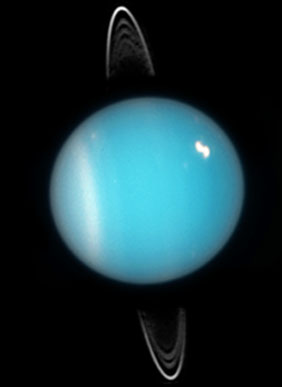 Uranus in visible light, observed by the Hubble Space Telescope. Public domain image by NASA/ESA from Wikimedia Commons. |
Since ancient times, people had known of five planets in the sky: Mercury, Venus, Mars, Jupiter, and Saturn. They were bright and easy to spot with the naked eye, and betrayed their difference to stars by their wandering loops across the sky, following much the same path as the sun. Some people supposed there might be fainter planets, but nobody had ever seriously looked for them. As with so many important scientific discoveries, by making a systematic and thorough survey of something else, Herschel had come across something that nobody really suspected.
When he announced his discovery it caused a sensation. Herschel became famous almost overnight, and found the interested patronage of his adopted king, George III. Herschel proposed naming the new planet in honour of the King, dubbing it Georgium Sidus, "George's Star" in Latin. Perhaps fortunately, French astronomers refused to adopt the name of the king of an enemy power, so called the new planet Herschel. Johann Bode proposed a name based on Greek mythology like the other planets: Uranus, the father of Saturn and grandfather of Jupiter. This quickly became the most popular choice, but His Majesty's Nautical Almanac Office held out, using Georgium Sidus until the 1850 edition of its famous Almanac, when it finally gave in. And so Herschel's new planet became, to the amusement of subsequent generations of English-speaking schoolchildren learning about the solar system, Uranus.
[Begin aside:]
Johann Bode, who first proposed the name, also bequeathed us with another contribution to our solar system. Prior to Herschel's discovery, Bode and Johann Titius had noticed a curious pattern in the orbital distances of the planets. If you take the numerical sequence 3, 6, 12, 24, 48, 96 - where each number is twice the one preceding - put a zero at the front (0, 3, 6, 12, 24, 48, 96), add four to each number (4, 7, 10, 16, 28, 52, 100), and finally throw out the fifth number (4, 7, 10, 16, 52, 100), then you are left with a series of numbers that roughly match the relative orbital distances of the planets known at the time when Titius and Bode pointed this out: Mercury, Venus, Earth, Mars, Jupiter, and Saturn. If the distance from Earth to the sun is taken to be 10 units, then Mercury is 3.9 units from the sun, Venus 7.2, Mars 15.2, Jupiter 52.0, and Saturn 95.4. The fact that there was no planet near 28 units from the sun (thus requiring the 28 to be thrown away), meant that this observation was looked on as more of a coincidental mathematical curiosity than anything else.
 Miranda, moon of Uranus, observed by Voyager 2. Public domain image by NASA from Wikimedia Commons. |
Just twenty years later, in 1801, Giuseppe Piazzi stunned the world. On the very first day of the 19th century, he had spotted through his telescope what he thought was a faint star. The next night when he observed the same patch of sky, the star wasn't at the position he'd recorded. He thought he must have recorded the position incorrectly. He checked again the following night, and discovered that the "star" was in fact moving. He confirmed this over several more nights, then wrote letters to two fellow astronomers (one of them Bode), saying he had discovered a comet, but thought that perhaps it might be something "better than a comet" since he could see none of the fuzzy nebulosity that typically surrounds a comet. The object moved into the glare of the sun and was only recovered towards the end of 1801, allowing its orbit to finally be calculated. The object was a planet. Its orbital distance: 27.7 units.
Piazzi proposed naming the planet Cerere Ferdinandea, after the Roman goddess of agriculture, Ceres, and King Ferdinand III of Sicily. Fortunately perhaps, in the same way that Uranus was not lumbered with being named after King George III, the Ferdinandea part was quickly dropped by other astronomers and the new planet became known simply as Ceres. Bode was ecstatic, and for several years thereafter the Titius-Bode Law was generally regarded as a more or less accurate predictor of planetary orbits. That status would erode and change in the following decades... but this aside has become too long already and that is a story for another day.
[End aside.]
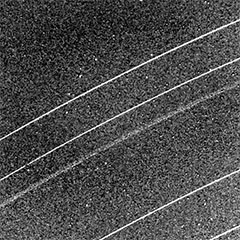 Rings of Uranus, observed by Voyager 2. Public domain image by NASA from Wikimedia Commons. |
We also knew by then that Uranus was a large planet, but not as large as Saturn or Jupiter. It is four times the diameter of Earth and about fifteen times its mass. From spectroscopy, we discovered that its atmosphere was mostly molecular hydrogen, helium, and methane. Its relatively low mass for its size indicates that the planet is composed mostly of ice - frozen water, ammonia, and methane - with a rocky core only about half the size of Earth. But apart from this, we knew nothing much else about Uranus until Voyager 2 flew past in 1986.
After the wonders of Jupiter and Saturn had been stunningly revealed by Voyagers 1 and 2, expectations were high that Uranus and its moons would be similarly amazing. Relatively speaking though, Uranus turned out to be somewhat disappointing. Voyager 2 discovered 11 tiny new moons, but all of the moons, including the previously known ones, were cratered and dead lumps of rock and ice, of more than passing interest only to keen geologists. And Uranus itself was ... well, boring. Jupiter had bold stripes and dramatic storms and fascinating swirls of colour that moved as Voyager approached. Saturn had its magnificent rings, which turned out to be much more complex and beautiful and full of interesting science up close than anyone had imagined. Uranus, on the other hand, presented a blank, featureless haze to Voyager 2. It was pale blue, and that was about the most interesting thing that could be said about the planet. Oh, there were measurements of magnetic fields and stuff which astronomers had fun with, but for the general public, Uranus was a dud.
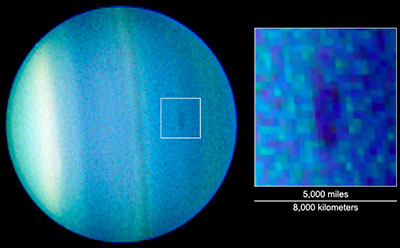 Structure in atmosphere of Uranus, viewed by the Hubble Space Telescope. Public domain image by NASA/ESA from Wikimedia Commons. |
Since Voyager 2, there have been no more probes visiting Uranus. But observations from Earth or Earth orbit improved, with the Hubble Space Telescope providing some of the best data we have Uranus so far. It has revealed subtle bands of cloud in Uranus's atmosphere, as well as storm systems similar to those seen on Jupiter and Saturn, and even aurorae. A modern probe, with better than 1970s technology, could tell us much more about the planet and almost certainly make it interesting again. One of the proposals for the final part of the Cassini mission to Saturn was to send the spacecraft on to Uranus. Unfortunately this was deemed impractical. There are some proposals for probes to be launched around 2020, with 10-20 year flight times to the planet, but for now there are no concrete plans to explore Uranus further.
Perhaps it may not be visited again within our lifetimes. Which would be a shame.
|
LEGO® is a registered trademark of the LEGO Group of companies,
which does not sponsor, authorise, or endorse this site. This material is presented in accordance with the LEGO® Fair Play Guidelines. |